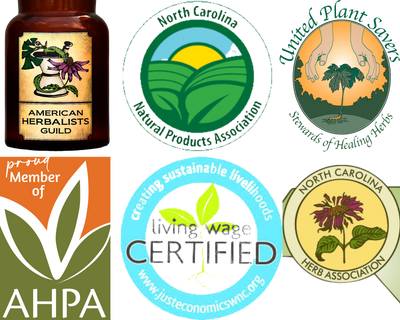Pine Needle Respiratory Ease Syrup
Pine needles are so abundant that almost everyone knows what they are and perhaps where to find them. Pine is also an incredible wound helper - though the sap is used more so than the needles - and because of pine's antioxidant and health-supportive properties we use it in our Breast Massage Oil. Pine is a foe to lumps and bumps of all kinds. The needles are a revered hub of vitamin C (ranging from as much to nearly 4 times as much as an orange). The older the needles, the more ascorbic acid content they have.
This syrup is so good that my three-year-old fakes a "smoker's hack" so that he can have an excuse to ask for some, which I willingly dole out even if he's not feeling sick. It's sweet and, well, pine-y, but thankfully not acrid or turpentine-y. I'll occasionally mix some in with my herbal tea or coffee just to give it a pine flavor boost. Pine is an expectorant for thinning and moving mucous in the lungs. It's warming, somewhat drying, and has a sweet and sour flavor blend that can only be described as piney.

For this syrup, I like to use Eastern white pine (Pinus strobus), which you can identify easily by picking up a cluster of the needles and checking that each little 'packet' or bunch has 5 needles. While most types of pine trees are good to use, be sure that what you're harvesting is not a yew tree (which are poisonous). The use of pine during pregnancy is not known, so it's probably safest for pregnant mamas to avoid.

As when wild harvesting anything, take caution to remember the basic principles of ethical wildcrafting: 1. know your plant ID and make sure you know what you're harvesting 2. take only what you need 3. use your common sense about where you are harvesting and what affect this might have on the plant specimen you're harvesting from and the surrounding plant and animal ecosystem. That said, pine is generous and there is almost no 'wrong' way to harvest pine needles. Pine branches or green needles dropped during a storm or gusty wind make for perfect harvesting.
Once you have a couple of cups of fresh green needles, take a deep whiff. Smell that resiny, aromatic fragrance? Those are the volatile oils within pine and these - along with its other constituents - will make your syrup taste as good as it smells.

Pine Needle Syrup
Making pine needle respiratory-ease syrup is super easy and essentially no more work than making a very strong pine tea and then 'holding' it with good quality, preferably raw, local honey.
2 cups fresh green pine needles
filtered or spring water
1/4-1/2 cup honey, to taste
You can either place your pine needles in a small pot whole (stripped off the branches or twigs, of course) or roughly chop them to expose more surface area. Cover the needles with water. This should end up being 2-3 cups of water. Bring to a boil and then simmer on low heat covered, until the liquid reduces by about half. Strain your liquid from the needles through a tea strainer, cheesecloth, or (my favorite) an old-fashioned potato ricer. Add around 1/4 - 1/2 cup honey to the resulting liquid while it's still warm and stir this in until it's dissolved.

Pine syrup can easily be mixed with my other favorite herbs for the upper and lower respiratory tracts: Breathe Light (goldenrod, ground ivy, and plantain), elecampane, wild cherry bark, violet, and ground ivy. Occasionally, even osha or lobelia in small amounts. The honey in the syrup itself is a tremendous beneficial aid to the lungs and a respiratory sedative and suppressant in its own right. It also acts as a natural preservative and will keep the syrup for up to one month in the fridge.
This syrup is wonderful for children (over one, of course). I dose it out about a teaspoon at a time, but you could do up to a tablespoon every 2-3 hours to support irritation in the lungs. Pine is such an abundant herb and tree that I often use it in several different variations throughout the seasons - as an herbal steam for the lungs, as a footpath, in bath salts, as a tea, and even as a vinegar.









Comments
Jeannie said:
Yes Charmaine any Pinus spp. interchangeable. And Charmaine yes! you can freeze . We love to use things fresh in peak season but freezing is a pretty sure way to get most of the benefits . Over time things do degrade. You might consider preserving with a little alcohol (1/2 alcohol , 1/2 syrup – 1:1) if you want a shelf stable product for longer times .
Lauren said:
Can this pine needle cough syrup be frozen to keep longer to bring out as need over the course of the cold season/year or does the freezing & thawing reduce its efficacy?
Charmaine Bell said:
Thank you this is very helpful. Is the Jeffrey pine needle same as white pine needles?